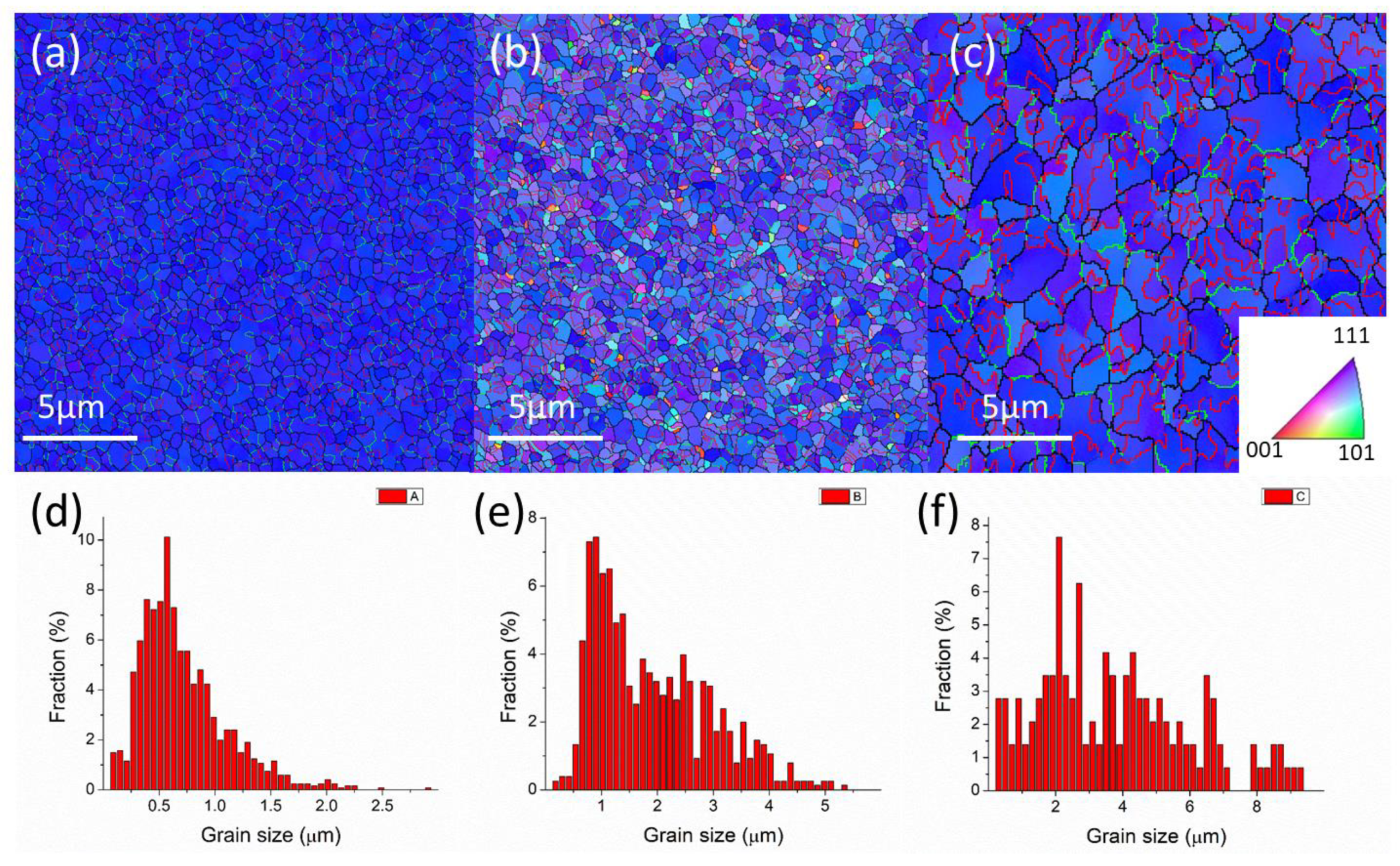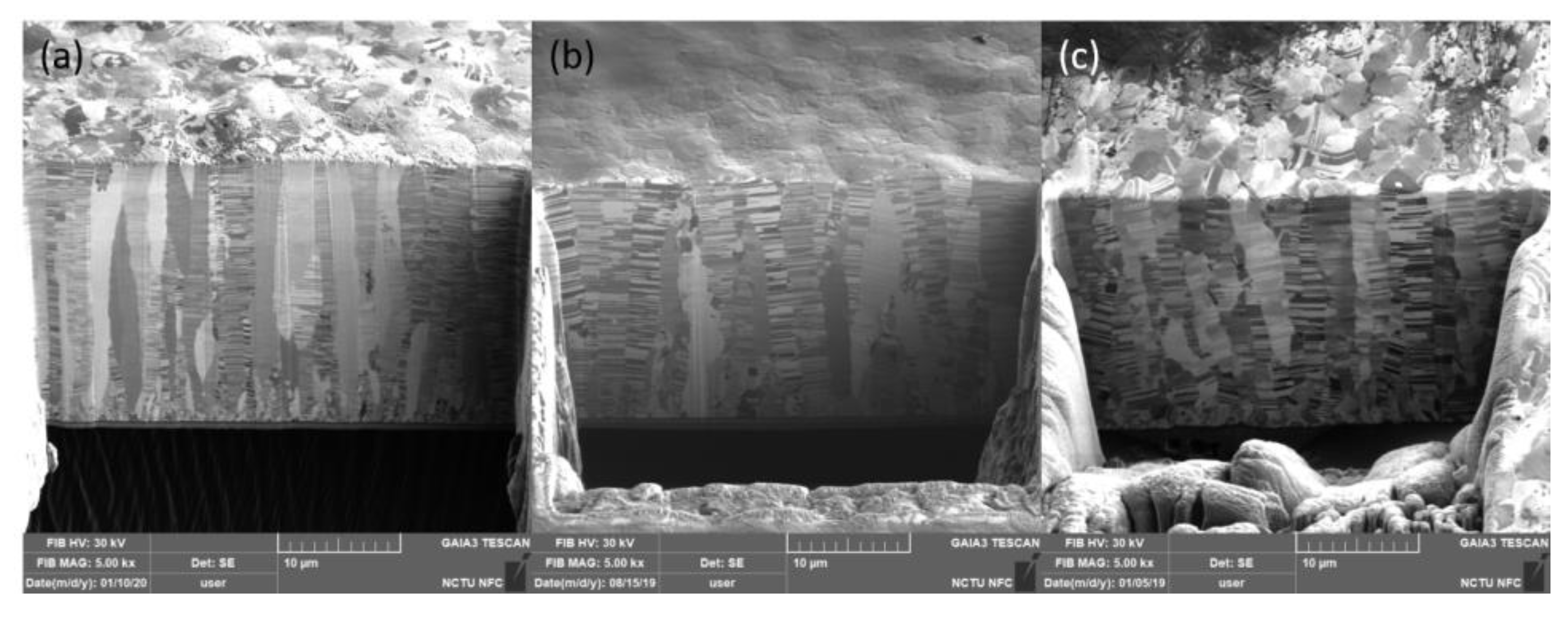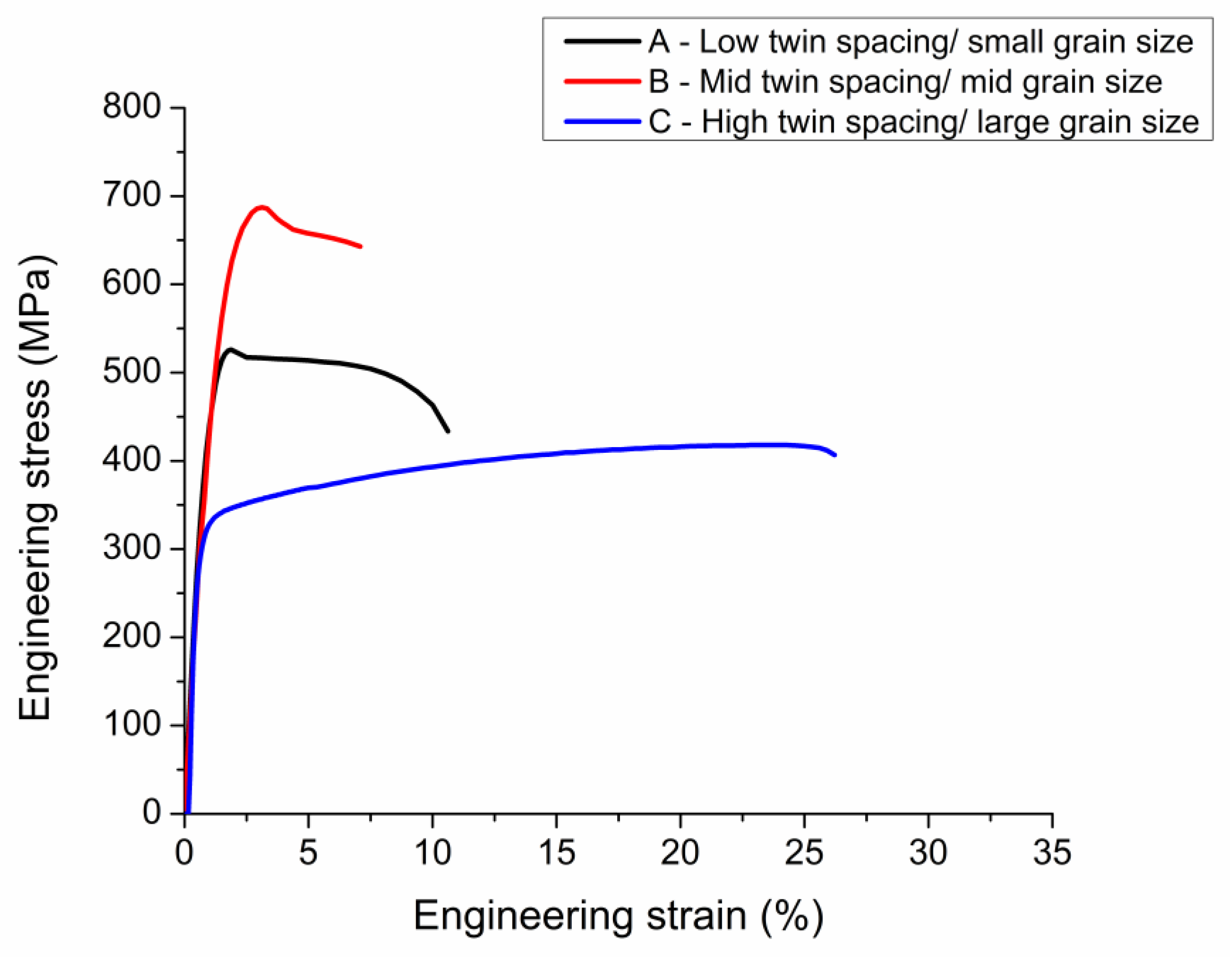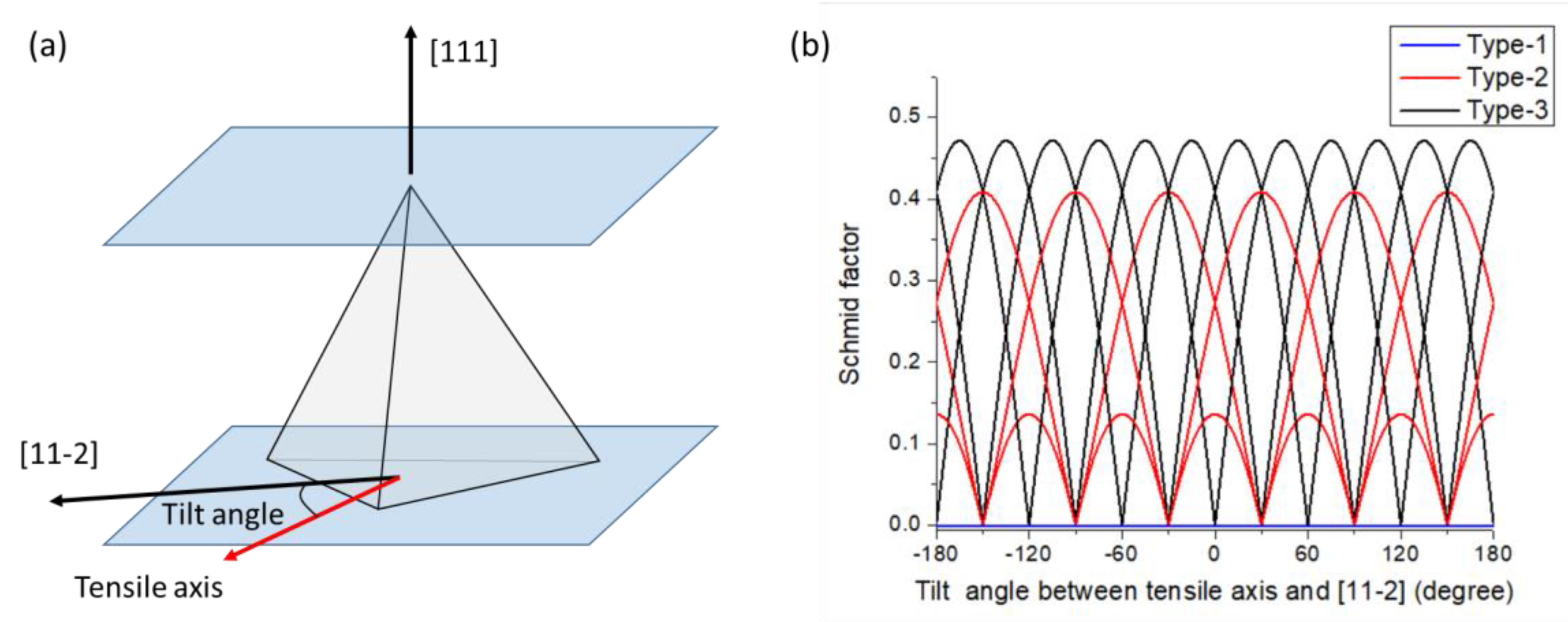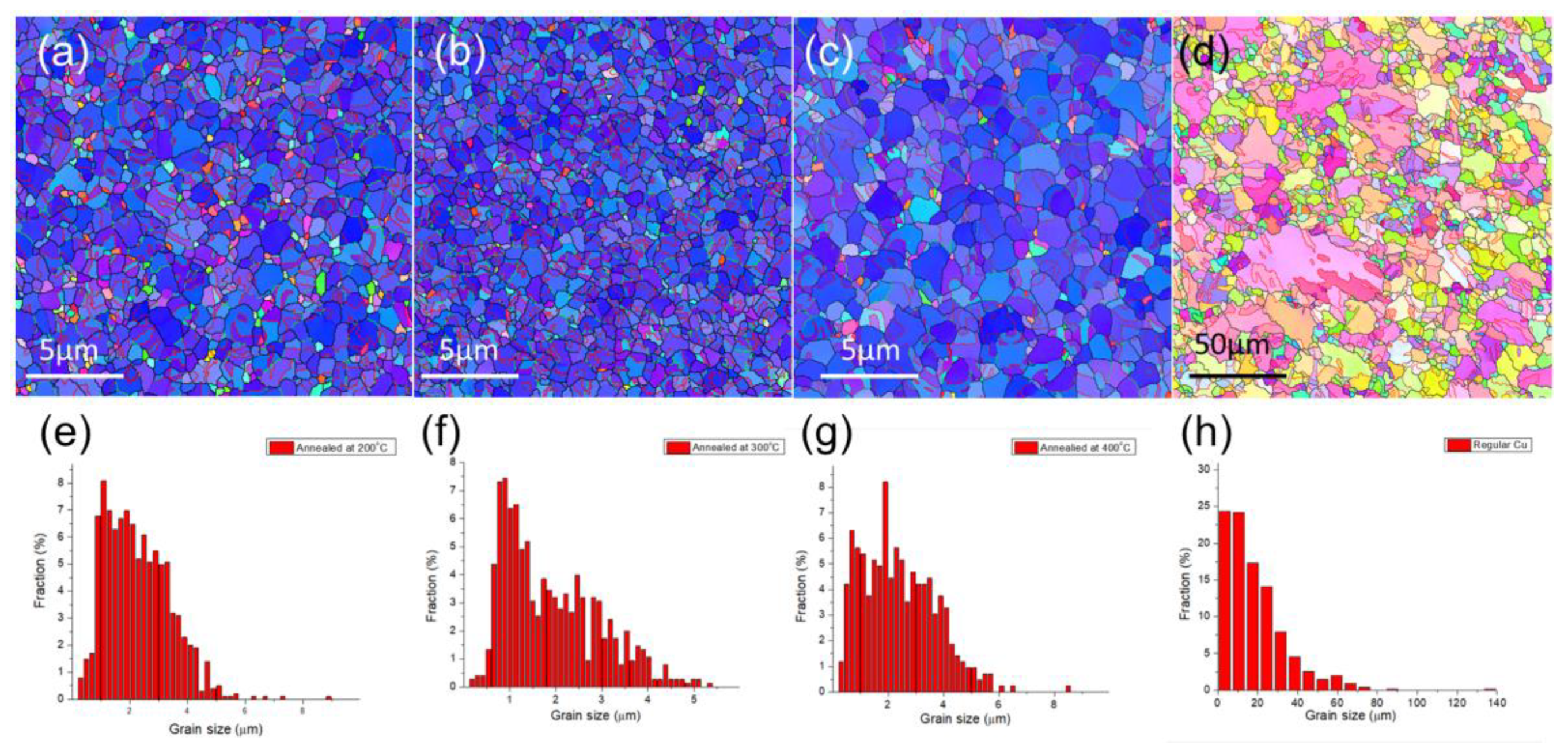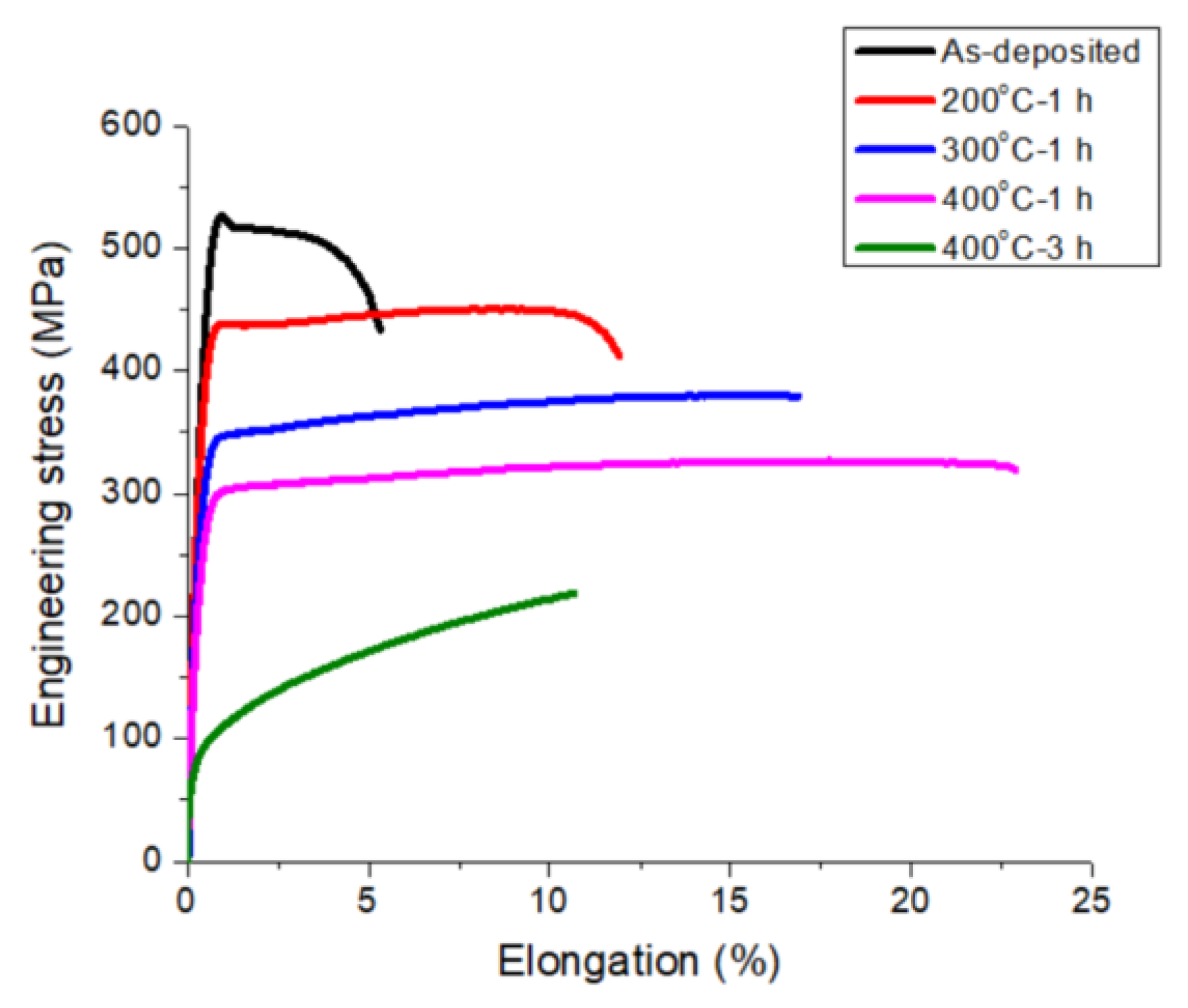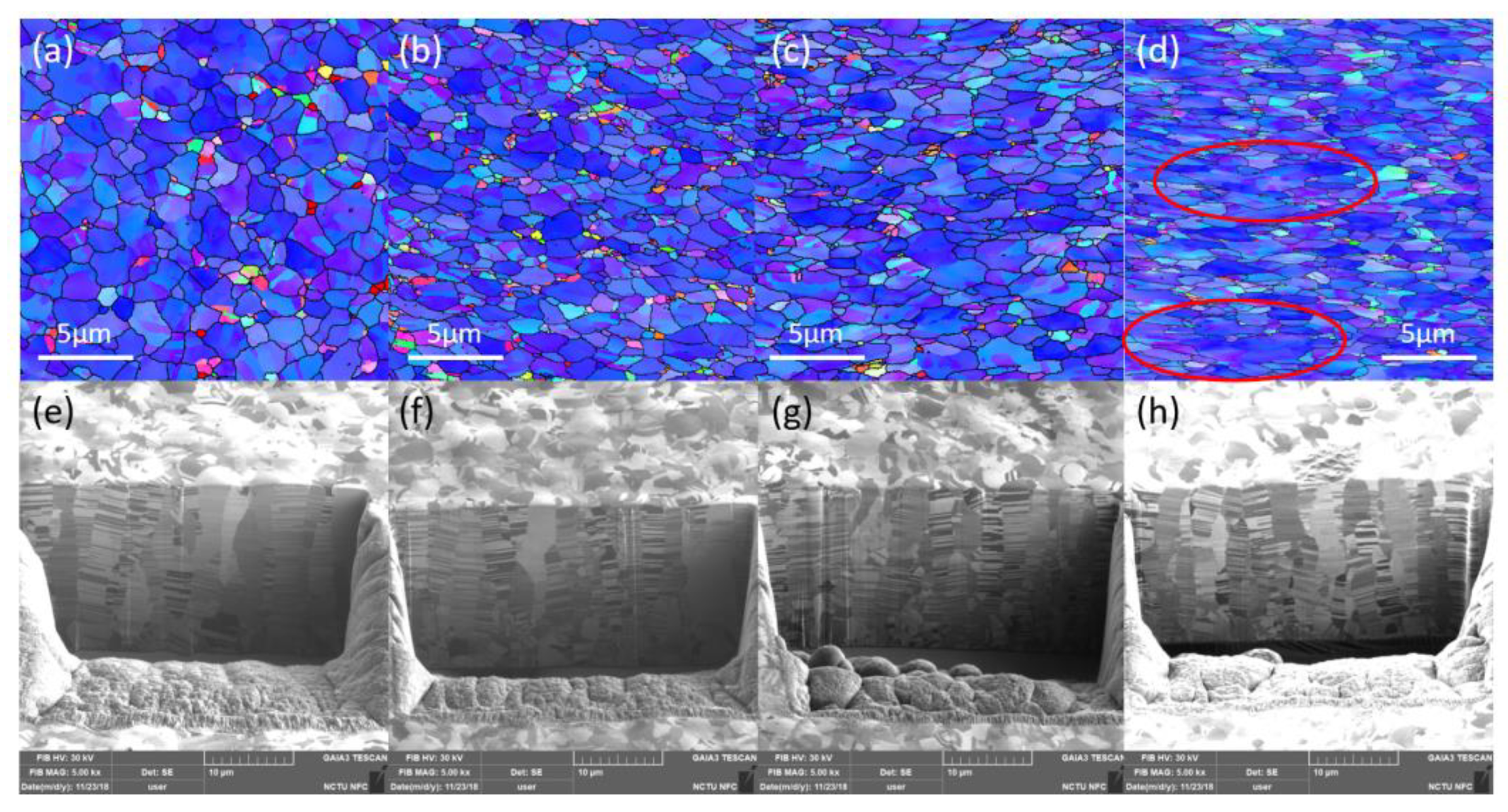3.1. Tuning of Microstructure With Different Additives During Electroplating
The microstructure of the three types of nt-Cu foils before the tensile test is shown in
Figure 2 and
Figure 3. From the top-view grain orientation image maps, the Cu foils are all shown to be highly <111>-oriented. The areal fraction of grains with {111} surface is higher than 95%. In
Figure 2a–c, the low angle grain boundary, high angle grain boundary, and twin boundary were marked with green lines, black lines, and red lines, respectively. In addition, most of the grain boundaries of the three types of nt-Cu are high angle grain boundaries. The grain size distributions of the three types of nt-Cu foils are shown in
Figure 2d–f. In this study, the average grain size and twin spacing were modified in two different ways. First, by adjusting the components of the electroplating bath, the average grain size of nt-Cu foils type-A, type-B, and type-C was 1.1, 2.9, and 6 μm, respectively. The copper foils showed similar columnar grains with high density twinning structure in the cross-sectional ion images; see
Figure 3. The average twin spacing of these nt-Cu foils was 31, 42, and 73 nm, respectively. The stress–strain curves of the nt-Cu foils are shown in
Figure 4. The yielding strength has a large range, which could be attributed to the as-deposited microstructure of <111>-oriented nt-Cu. Type-A nt-Cu has the lowest twin spacing and the smallest grain size; type-B nt-Cu has mid twin spacing and mid grain size; and type-C nt-Cu has the largest twin spacing and grain size among the three types of nt-Cu. The stress-drop at the fracturing point was caused by serious necking. For type-A and type-B, an obvious necking point formed after the yielding point, and the elongation was dominated by the necking point. In contrast, the necking behavior is relatively uniform in the type-C Cu foil, the shrinkage in the width direction was observed through the gauge length. By comparing the grain size and twin spacing, we tuned the microstructure to obtain the desired mechanical properties.
Grain boundary strengthening is a well-known strengthening mechanism in materials. However, the high density twinned structure would limit the density and mobility of dislocation. The Hall–Petch equation explains the effect of grain size on yield strength; see Equation (1). Normally, for copper, the grain size needs to reach nanoscale to show an obvious increase in yield strength. However, in our experiment, we observed a yield strength of 698 MPa with grains of micron size. Therefore, we assume the traditional explanation of grain boundary strengthening is inadequate to cover nanotwinned copper owing to the presence of nanotwins.
is the friction stress;
is strengthening coefficient, and d is average grain diameter. The limiting mechanism of the interlayer thickness of multi-layer materials was derived in the confined layer slip (CLS) model [
16]. Substituting the limiting thickness with twin spacing in this model can result in Equation (2).
where M is the Taylor factor,
μ is the shear modulus, b is the Burger’s vector component,
λ is the twin spacing,
α is the material constant related to the dislocation core, and
β is Poisson’s ratio.
Taylor’s law could explain deformation in multi-slipping systems, yet grains in columnar <111>-oriented copper nanotwins have identical slip plane systems and similar slip behavior, along with the highly z-directional preferred orientation. In a highly <111>-oriented nanotwinned copper, if the {111} twin plane is defined as a normal (111) plane, it becomes harder to slip owing to Schmid’s factor. When the tensile axis is parallel to the coherent twin plane, the shear stress on the surface is 0 (the slip systems of dislocations between two coherent twin boundaries are shown in
Figure 5). In face-centered-cubic (FCC), there are 12 individual slip systems that were components in 4 slip planes and with 3 slip directions for each slip plane. The slip systems between two twin boundaries could be divided into three types. In type 1, the slip plane and slip direction of the dislocation are parallel to the twin boundaries; in type 2, the slip plane and slip direction of the dislocation are both non-parallel to the twin boundaries; and in type 3, the slip plane is non-parallel to the twin boundaries, but the slip direction is parallel to the twin boundary.
To clarify the main differences among the three types of slip systems, we defined the twin plane as the (111) plane in a columnar grain. In this study, the tensile axis is parallel to the twin plane, which means the tensile axis must be vertical to the normal twin plane (111). In this situation, we defined [11
] vector as a reference direction of tensile axis and the rotation axis is defined as [111] (
Figure 6a). We calculate the Shmid factor of the three types of slip systems.
Figure 6b indicated that the Schmid factor of type 1 slip systems is 0, and the value of type 3 will always be higher than the value of type 2, except for some specific points with a tilt angle of 30° ± n × 60°. The directions with a tilt angle of 30° ± n × 60° were identified to be ±[
], ±[
], and ±[
]. In other words, when the tensile axis is parallel to ±[
], ±[
], and ±[
], Schmid factor of type 2 slip systems will be equal to the value of type 3. However, dislocations of the type 2 slip system need additional stress (0.8 GPa) to pass through the twin boundary [
17]; that is, even if the Schmid factors are equal, dislocations still require more stress in the type 2 slip system than in the type 3 slip system to drive macroscopic deformation. The dislocation density results reported in previous studies support this theory [
13,
14,
18].
Therefore, we can assume that there is only the type 3 slip system that has three individual slip systems in each highly <111>-oriented columnar nt-Cu grain. However, the assumption for Taylor’s theory required five independent slip systems in each grain, which means Taylor’s theory is unsuitable for the plastic deformation of columnar nt-Cu conducted in this study.
The main feature from Schmid law is the higher priority in deformation of harder grains over softer grains under tensile stress, even if the critical torque has been reached at lower stresses. There are only three viable slip planes in the highly-oriented nanotwinned copper. Under the circumstance of limited slip systems, while having the same (111) plane, the effect of the Schmid factor is not obvious. It is well known that when FCC structure slip systems are under tensile forces perpendicular to the <111> direction, the Schmid factor has a minimum value of
along the <
> and <
> direction. This is nearly identical to the average Schmid factor value on the tensile direction that we have obtained in our EBSD analysis, that is, 0.45 ± 0.03. Therefore, in <111>-oriented nt-Cu, the slip system in every columnar grain is very similar, and under plastic deformation, the overall yield strength will be very similar owing to similar Schmid factors, which would reduce work hardening formed by dislocation entanglement, as shown in
Figure 4. However, in order to observe this phenomenon clearly, a very small twin spacing is required.
Thus, we confirm that, on a highly <111>-oriented columnar nanotwinned copper, the columnar grain strength perpendicular to the tensile strength is identical in every grain. Therefore, the difference of critical torque between different grains needed to reach activation in plane slip becomes similar to single crystals. The Schmid factor for single crystals is much more suitable than the Taylor factor to explain the deformation in nanotwinned copper, despite that it is a polycrystalline system. Equation (3) is an alternation of the Schmid factor. The stress value represents different strengthening values under different twin densities.
In this experiment, the twin spacing is a variable. If we consider grain size along with twin spacing, we end up with Equation (4). The difference from previous literature is that all interfaces between different grain layers are fully connected, but we speculate from the microstructure observed by ion beam images that not all neighboring twin grains are fully aligned, despite them having a highly preferred orientation. The diameter of the columnar grains will affect the density of dislocation within the grains [
19], and thus the effect of grain size on decreasing yield strength must be considered.
The parameters are substituted into Equation (4) [
7,
16,
19], where
is the friction stress = 25 MPa and K
y is the grain boundary strengthening coefficient. We implement the average values obtained from the EBSD analysis before the tensile tests, Schmid factor = 0.45,
= 0.218, and
= 0.16, and substitute the nanotwins’ twin spacing and grain diameter of all tested samples into Equation (4) to obtain the yield strength of nanotwinned copper A, B, and C to be 715 MPa, 548 MPa, and 374 MPa, respectively, which are very close to our experimental results.
3.2. Altering the Mechanical Properties of Nanotwinned Copper by Annealing
We studied the effect of various annealing temperatures on the B-type nanotwinned copper. Grain size was obtained from the EBSD results and twin spacing was calculated via cross-section ion beam image. As seen in
Figure 7a–c, nanotwinned copper annealed at 200–400 °C for an hour does not show obvious grain growth, nor a change of its preferred orientation. As the annealing temperature increases, we can see from the EBSD images that the grain size also increases. The average grain size of samples annealed at 200 °C, 300 °C, and 400 °C for 1 h is 2.95, 3.3, and 3.7 μm, respectively. The average grain size of samples annealed at 400 °C for 3 h has a diameter of 18.4 μm.
The ion beam images of annealed samples at various temperatures are shown in
Figure 8. From
Figure 7 and
Figure 8, we can observe the trend of increasing grain diameter and twin spacing after annealing. Columnar <111>-oriented nanotwinned copper was proven to have great thermal stability. In this study, it is able to withstand annealing at 400 °C for 1 h and maintain its preferred orientation. On the other hand, after annealing at 400 °C for 3 h, the surface of the nanotwinned structure will lose its <111> orientation and transform into randomly oriented large grains. From the cross-section images, we can no longer observe twinned grains parallel to the surface after annealing, instead a few micron-scaled annealed grains that can be viewed as large copper grains. From the cross-section ion beam image, we are able to calculate the twin spacing, which is 55, 82, and 98 nm for samples annealed at 200 °C, 300 °C, and 400 °C, respectively. The strain–stress curve from the tensile tests is shown in
Figure 9, where we observe that, with the increasing annealing temperature, there will be an increase in ductility, but with a decrease in yield strength. The increase in ductility continues until the microstructure undergoes a massive change, when the high twin density disappears or when there is no longer a preferred orientation. The copper film will then show a decrease in ductility, and we can observe a decrease in yield strength and obvious work hardening.
From the conclusion in the last section, we substitute the microstructure parameters from the post-annealing results into Equation (4) to obtain the theoretical yield strength. The value is 462, 356, and 317 MPa for samples annealed at 200 °C, 300 °C, and 400 °C for 1 h, respectively, which is very close to the results obtained in the tensile tests. Concerning the large copper grains, as there are no nano-scale twins or layer-like structure to hinder its dislocation slip, the CLS model is not suitable. However, we can assume from the tensile curves in
Figure 9 that, without the presence and the limitations of dislocation slip interfaces, the dislocations can entangle during slip, causing a notable work hardening. Besides, as the entanglement of dislocation causes discontinuity of dislocation slip, we observed, in the 400 °C for 3 h sample, an elongation decrease of 10%, roughly half of the 400 °C for 1 h sample or the type-C sample from
Figure 4. The parameters of the annealed nt-Cu foils are substituted into Equation (4), and the predicted yield strengths for as-deposited, 200 °C, 300 °C, and 400 °C annealing for 1 h are 548 MPa, 464 MPa, 364 MPa, and 326 MPa, respectively. The experimental results are very close to the theoretical values.
We observed the microstructures of type-B copper foils annealed at 400 °C with different deformation scenarios, as shown in
Figure 10. From the EBSD results, we observed an obvious elongation of the <111> columnar grains, and the unchanged structure of non-<111> grains from
Figure 10a–d. This implies that, during the deformation process, the strain rates between different grains are uneven. Elongation is mainly dependent on the strain rate of the columnar grain under tensile stress.
Besides the above discussed strengthening model, we also observed an increase in elongation with the decrease in sample strength, which corresponds well to previous studies [
7]. However, in previous studies, as the deformation increases, many sub-grains or dislocation cells appear on the boundaries of the columnar nanotwinned copper grains. It is not observed in this study, from ion beam images of the cross-section microstructure (
Figure 10a–h), we can see that no sub-grains were present. Instead, we can observe, from the surface EBSD analysis, an increase in average grain size, where grains are able to reach up to 15 μm in diameter. This suggests that nanotwinned copper undergoes grain growth under tensile strength, which has not been reported in previous studies. In addition, in other columnar twin copper foil studies [
2,
9,
20], elongation rates are commonly not ideal, plus the fact that thickness will greatly affect the elongation rates. It is rare to observe an elongation rate of over 25% with a thickness thinner than 20 μm.

